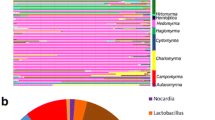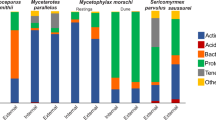Abstract
Ants are an ecologically and evolutionarily diverse group, and they harbor a wide range of symbiotic microbial communities that often greatly affect their biology. Turtle ants (genus Cephalotes) engage in mutualistic relationships with gut bacteria and are exploited by microbial parasites. Studies have shown that associations among these microbial lineages and the turtle ant hosts vary geographically. However, these studies have been limited, and thorough within-species analyses of the variation and structure of these microbial communities have yet to be conducted. The giant turtle ant, Cephalotes atratus (Linnaeus 1758), is a geographically widespread, genetically diverse Neotropical species that has been sampled extensively across its geographic range, making it ideal for analysis of microbial associations. In this study, we verified the presence, genetic variation, and geographic patterns at the individual, colony, and population level of three microbial groups associated with the giant turtle ant: Wolbachia, a genus of facultative bacteria which are often parasitic, affecting host reproduction; Rhizobiales, a mutualistic order of bacteria hypothesized to be an obligate nutritional symbiont in turtle ants; and Ophiocordyceps, a genus of endoparasitic fungi infecting many arthropod species by manipulating their behavior for fungal reproduction. In this study, we found varying degrees of prevalence for two distantly related genotypes (haplogroups) of Wolbachia and high degree of prevalence of Rhizobiales across colonies with little genetic variation. In addition, we found low occurrence of Ophiocordyceps. This study highlights a key first step in understanding the diversity, distribution, and prevalence of the microbial community of C. atratus.



Similar content being viewed by others
References
Ahmed M, Li S, Xue X, Yin X, Ren S, Jiggins F, Greeff J, Qiu B (2015) The intracellular bacterium Wolbachia uses parasitoid wasps as phoretic vectors for efficient horizontal transmission. PLoS Pathog 11(2)
Arai H, Hirano T, Akizuki N, Abe A, Nakai M, Kunimi Y, Inoue MN (2019) Multiple infection and reproductive manipulations of Wolbachia in Homona magnanima (Lepidoptera: Tortricidae). Microb Ecol 77:257–266
Araújo J, Evans H, Geiser D, Mackay W, Hughes D (2015) Unravelling the diversity behind the Ophiocordyceps unilateralis (Ophiocordycipitaceae) complex: three new species of zombie-ant fungi from the Brazilian Amazon. Phytotaxa 220(3):224
Bailly-Bechet M, Martins-Simões P, Szöllősi GJ, Mialdea G, Sagot MF, Charlat S (2017) How long does Wolbachia remain on board? Mol Biol Evol 34:1183–1193
Bandelt HJ, Forster P, Röhl A (1999) Median-joining networks for inferring intraspecific phylogenies. Mol Biol Evol 16:37–48
Baldo L, Hotopp JC, Jolley KA, Bordenstein SR, Biber SA, Choudhury RR, Hayashi C, Maiden MC, Tettelin H, Werren JH (2006) Multilocus sequence typing system for the endosymbiont Wolbachia pipientis. Appl Environ Microbiol 72:7098–7110. https://doi.org/10.1128/AEM.00731-06
Blochmann F (1882) Uber das Vorkommen bakterienahn-licher Gebilde in den Geweben und Eiern verschiedener Insekten. Zbl Bakt 11:234–240
Brown BP, Wernegreen JJ (2016) Deep divergence and rapid evolutionary rates in gut-associated Acetobacteraceae of ants. BMC Microbiol 16:140
Corn, ML (1976) The ecology and behavior of Cephalotes atratus, a Neotropical ant (Hymenoptera: Formicidae). PhD Thesis, Harvard University
Currie C, Scott J, Summerbell R, Malloch D (1999) Fungus-growing ants use antibiotic-producing bacteria to control garden parasites. Nature 398:701–704
De Andrade, M. L., & Urbani, C. B. (1999). Diversity and adaptation in the ant genus Cephalotes, past and present. Staatliches Museum für Naturkunde.
de Souza D, Bézier A, Depoix D, Drezen J, Lenoir A (2009) Blochmannia endosymbionts improve colony growth and immune defence in the ant Camponotus fellah. BMC Microbiol 9(29)
Engel P, Moran N (2013) The gut microbiota of insects – diversity in structure and function. FEMS Microbiol Rev 37(5):699–735
Erlacher A, Cernava T, Cardinale M, Soh J, Sensen CW, Grube M, Berg G (2015) Rhizobiales as functional and endosymbiontic members in the lichen symbiosis of Lobaria pulmonaria L. Front Microbiol 6:53
Evans H, Elliot S, Hughes D (2011) Hidden Diversity Behind the Zombie-Ant Fungus Ophiocordyceps unilateralis: Four New Species Described from Carpenter Ants in Minas Gerais, Brazil. PLoS One 6(3)
Evans HC (1982) Cordyceps species and their anamorphs pathogenic on ants (Formicidae) in tropical forest ecosystems I. The Cephalotes (Myrmicinae) complex. Trans Br Mycol Soc 79(3):431–453
Feldhaar H, Straka J, Krischke M, Berthold K, Stoll S, Mueller M, Gross R (2007) Nutritional upgrading for omnivorous carpenter ants by the endosymbiont Blochmannia. BMC Biol 5(48)
Frost C, Fernandez-Marin H, Smith J, Hughes W (2010) Multiple gains and losses of Wolbachia symbionts across a tribe of fungus-growing ants. Mol Ecol 19(18):4077–4085
Frost C, Pollock S, Smith J, Hughes W (2014) Wolbachia in the Flesh: Symbiont Intensities in Germ-Line and Somatic Tissues Challenge the Conventional View of Wolbachia Transmission Routes. Plos ONE 9(7)
Hilgenboecker K, Hammerstein P, Schlattmann P, Telschow A, Werren JH (2008) How many species are infected with Wolbachia? — a statistical analysis of current data. FEMS Microbiol Lett 281:215–220
Hu Y, Sanders JG, Łukasik P, D’Amelio CL, Millar JS, Vann DR, Lan Y, Newton JA, Schotanus M, Kronauer DJC, Pierce NE, Moreau CS, Wertz JT, Engel P, Russell JA (2018) Herbivorous turtle ants obtain essential nutrients from a conserved nitrogen-recycling gut microbiome. Nat Commun 9(1):964
Hu Y, Łukasik P, Moreau C, Russell J (2013) Correlates of gut community composition across an ant species (Cephalotes varians) elucidate causes and consequences of symbiotic variability. Mol Ecol 23(6):1284–1300
Hu YI (2015) The role of symbiotic bacteria in the evolution of ant herbivory. PhD Thesis, Drexel University
Kautz S, Rubin B, Moreau C (2013) Bacterial infections across the ants: frequency and prevalence of Wolbachia, Spiroplasma, and Asaia. A Journal of Entomology, Psyche, pp 1–11
Kearse M, Moir R, Wilson A, Stones-Havas S, Cheung M, Sturrock S, Buxton S, Cooper A, Markowitz S, Duran C, Thierer T, Ashton B, Mentjies P, Drummond A (2012) Geneious Basic: an integrated and extendable desktop software platform for the organization and analysis of sequence data. Bioinformatics 28(12):1647–1649
Kempf WW (1951) A taxonomic study on the ant tribe Cephalotini (Hymenoptera: Formicidae). Rev Entomol Rio de Janeiro 22:1–244
Martins C, Souza RF, Bueno OC (2012) Presence and distribution of the endosymbiont Wolbachia among Solenopsis spp. (Hymenoptera: Formicidae) from Brazil and its evolutionary history. J Invertebr Pathol 109(3):287–296
Moreau CS (2014) A practical guide to DNA extraction, PCR, and gene-based DNA sequencing in insects. Halteres 5:32–42
Pinto-Tomas A, Anderson M, Suen G, Stevenson D, Chu F, Cleland W (2009) Symbiotic nitrogen fixation in the fungus gardens of leaf-cutter ants. Science 326(5956):1120–1123
Pontieri L, Schmidt AM, Singh R, Pedersen JS, Linksvayer TA (2017) Artificial selection on ant female caste ratio uncovers a link between female-biased sex ratios and infection by Wolbachia endosymbionts. J Evol Biol 30:225–234
Price S, Powell S, Kronauer D, Tran L, Pierce N, Wayne R (2014) Renewed diversification is associated with new ecological opportunity in the Neotropical turtle ants. J Evol Biol 27(2):242–258
Ramalho MO, Martins C, Silva LM, Martins VG, Bueno OC (2017a) Intracellular symbiotic bacteria of Camponotus textor, Forel (Hymenoptera, Formicidae). Curr Microbiol 74(5):589–597
Ramalho MO, Bueno OC, Moreau CS (2017b) Microbial composition of spiny ants (Hymenoptera: Formicidae: Polyrhachis) across their geographic range. BMC Evol Biol 17(1):96
Ramalho MO, Vieira AS, Pereira MC, Moreau CS, Bueno OC (2018) Transovarian transmission of Blochmannia and Wolbachia endosymbionts in the Neotropical weaver ant Camponotus textor (Hymenoptera, Formicidae). Curr Microbiol:1–8
R Development Core Team (2018) R: A language and environment for statistical computing. Available from http://www. R-project.org/.
Russell JA, Moreau CS, Goldman-Huertas B, Fujiwara M, Lohman DJ, Pierce NE (2009a) Bacterial gut symbionts are tightly linked with the evolution of herbivory in ants. Proc Natl Acad Sci 106(50):21236–21241
Russell J, Funaro C, Giraldo Y, Goldman-Huertas B, Suh D, Kronauer D, Moreau C, Pierce N (2012) A Veritable Menagerie of Heritable Bacteria from Ants, Butterflies, and Beyond: Broad Molecular Surveys and a Systematic Review. PLoS One 7(12)
Russell J, Goldman-Huertas B, Moreau C, Baldo L, Stahlhut J, Werren J, Pierce N (2009b) Specialization and geographic isolation among Wolbachia symbionts from ants and Lycaenid butterflies. Evolution 63:624–640
Sanjuan TI, Franco-Molano AE, Kepler RM, Spatafora JW, Tabima J, Vasco-Palacios AM, Restrepo S (2015) Five new species of entomopathogenic fungi from the Amazon and evolution of neotropical Ophiocordyceps. Fungal Biology 119(10):901–916
Souza R, Martins C, Pereira R, Bueno O (2014) Analysis of the hypervariable regions (HVRs) of the wsp Gene of Wolbachia from Solenopsis invicta ants in Southeastern Brazil. Advances in Entomology 2:135–143
Stahlhut JK, Desjardins CA, Clark ME, Baldo L, Russell JA, Werren JH, Jaenike J (2010) The mushroom habitat as an ecological arena for global exchange of Wolbachia. Mol Ecol 19:1940–1952
Stoll S, Gadau J, Gross R, Feldhaar H (2007) Bacterial microbiota associated with ants of the genus Tetraponera. Biol J Linn Soc 90(3):399–412
Stouthamer R, Breeuwer J, Hurst G (1999) Wolbachia pipientis: Microbial manipulator of arthropod reproduction. Annu Rev Microbiol 53:71–102
Sung G, Hywel-Jones N, Sung J, Luangsa-ard J, Shrestha B, Spatafora J (2007) Phylogenetic classification of Cordyceps and the Clavicipitaceous fungi. Stud Mycol 57:5–59
Tolley SJ, Nonacs P, Sapountzis P (2019) Wolbachia horizontal transmission events in ants: what do we know and what can we learn? Front Microbiol. https://doi.org/10.3389/fmicb.2019.00296
Trifinopoulos J, Nguyen LT, Von Haeseler A, Minh BQ (2016) W-IQ-TREE: a fast online phylogenetic tool for maximum likelihood analysis. Nucleic Acids Res 44:232–235
Van Borm S, Wenseleers T, Billen J, Boomsma J (2001) Wolbachia in leafcutter ants: a widespread symbiont that may induce male killing or incompatible matings. J Evol Biol 14(5):805–814
Vieira AS, Ramalho MO, Martins C, Martins VG, Bueno OC (2017) Microbial communities in different tissues of Atta sexdens rubropilosa leaf-cutting ants. Curr Microbiol 74(10):1216–1225
Wenseleers T, Ito F, Van Borm S, Huybrechts R, Volckaert F, Billen J (1998) Widespread occurrence of the micro-organism Wolbachia in ants. Proc R Soc B 265:1447–1452
Wernegreen JJ, Kauppinen SN, Brady SG, Ward PS (2009) One nutritional symbiosis begat another: phylogenetic evidence that the ant tribe Camponotini acquired Blochmannia by tending sap-feeding insects. BMC Evol Biol 9(1):292
Werren J, Baldo L, Clark M (2008) Wolbachia: master manipulators of invertebrate biology. Nat Rev Microbiol 6:741–751
Yun Y, Lei C, Peng Y, Liu F, Chen J, Chen L (2011) Wolbachia strains typing in different geographic population spider, Hylyphantes graminicola (Linyphiidae). Curr Microbiol 62(1)
Zhou W, Rousset F, O'Neill S (1998) Phylogeny and PCR–based classification of Wolbachia strains using wsp gene sequences. Proc R Soc Lond B Biol Sci 265(1395):509–515
Competing Interests
The authors declare that they have no competing interests.
Funding
We thank the National Science Foundation Research Experience for Undergraduates site grant program (NSF DBI 1559779) for support of D.D.R. and C.S.M. thanks the National Science Foundation (NSF DEB 1900357) for support.
Author information
Authors and Affiliations
Contributions
Destiny D. Reeves, Shauna L. Price, and Corrie S. Moreau contributed to the study conception and design. Material preparation, data collection, and analysis were performed by Destiny D. Reeves, Shauna L. Price, and Manuela O. Ramalho. The first draft of the manuscript was written by Destiny D. Reeves and Shauna L. Price, and all authors commented on previous versions of the manuscript. All authors read and approved the final manuscript.
Corresponding author
Ethics declarations
All authors declare that any authorization needed for collecting biological specimens on environmental protected areas has been obtained from government authorities of the countries where collecting has taken place.
Additional information
Edited by Alberto S Corrêa – ESALQ/USP
Publisher’s Note
Springer Nature remains neutral with regard to jurisdictional claims in published maps and institutional affiliations.
Rights and permissions
About this article
Cite this article
Reeves, D.D., Price, S.L., Ramalho, M.O. et al. The Diversity and Distribution of Wolbachia, Rhizobiales, and Ophiocordyceps Within the Widespread Neotropical Turtle Ant, Cephalotes atratus (Hymenoptera: Formicidae). Neotrop Entomol 49, 52–60 (2020). https://doi.org/10.1007/s13744-019-00735-z
Received:
Accepted:
Published:
Issue Date:
DOI: https://doi.org/10.1007/s13744-019-00735-z




